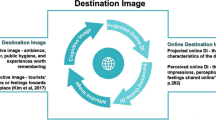Abstract
History and cultural heritage are an integral part of place identity, infrastructure and landscape. This article explores the process of using local history and cultural heritage as a foundation for branding a small-scale tourist destination in China. We will study the branding project of Shouxian Tofu Village in China, in application with the 4D Place Branding Model specifically designed for branding cities in China. This article also provides some clues on the issues that limit the process of place branding in China.

Similar content being viewed by others
References
Abankina, T. (2013) Regional development models using cultural heritage resources. International Journal of Culture, Tourism and Hospitality Research 7 (1): 3–10.
Gertner, D. and Kotler, P. (2004) How can a place correct a negative image? Place branding 1 (1): 50–57.
Gnoth, C., Godehardt, E., Frank-Herrmann, P., Friol, K., Tigges, J. and Freundl, G. (2005) Definition and prevalence of subfertility and infertility. Human Reproduction 20 (5): 1144–1147.
Gupta, A. (2010) Branding a nation: Framework for building favorable country-image. Drishtikon: A Management Journal 1 (2): 222–243.
Hanna, S. and Rowley, J. (2008) An analysis of terminology use in place branding. Place Branding and Public Diplomacy 4 (1): 61–75.
Kavaratzis, M. (2004) From city marketing to city branding: Towards a theoretical framework for developing city brands. Place branding 1 (1): 58–73.
Kavaratzis, M. (2009) Cities and their brands: Lessons from corporate branding. Place Branding and Public Diplomacy 5 (1): 26–37.
Kavaratzis, M. and Ashworth, G. (2006) City branding: An effective assertion of identity or a transitory marketing trick? Place Branding 2 (3): 183–194.
Konecnik, M. and Go, F. (2008) Tourism destination brand identity: The case of Slovenia. Journal of Brand Management 15 (3): 177–189.
Kotler, P. (1999) Marketing Places Europe. 1st edn. London: Financial Times Prentice Hall.
Kotler, P. and Andreasen, A.R. (1991) Strategic Marketing for Non-profit Organizations. 4th edn. Englewood Cliffs, New Jersey: Prentice Hall.
Kunzmann, K.R. (2004) Culture, creativity and spatial planning. Town Planning Review 75 (4): 383–404.
Lin, G.C.S. (2009) Developing China: Land, Politics and Social Conditions. Oxford: Routledge.
Lodge, C. (2006) Opinion pieces: Where is place branding heading. Place Branding 1 (1): 12–35.
Morgan, N. (2006) Opinion pieces: How has place branding developed during the year that place branding has been in publication. Place Branding 2 (1): 6–17.
Papadopoulos, N., Heslop, L.A. and Mourali, M. (2005) The influence of country image structure on consumer evaluations of foreign products. International Marketing Review 22 (1): 96–115.
Russell, D., Mort, G. and Hume, M. (2009) Analysis of management narrative to understand social marketing strategy: The case of ‘Branding Logan City’. Australasian Marketing Journal (AMJ) 17 (4): 232–237.
Van der Burg, J. and Russo, A.P. (2005) The Impacts of Culture on the Economic Development of Cities. A research into the cultural economies and policies of Amsterdam, Bolzano, Edinburgh, Eindhoven, Klaipeda, Manchester, Rotterdam, Tampere, The Hague and Vienna. European Institute for Comparative Urban Research (EURICUR). Erasmus University Rotterdam.
Van Ham, P. (2008) Place branding: The state of the art. The Annals of the American Academy of Political and Social Science 616 (1): 126–149.
Author information
Authors and Affiliations
Corresponding author
Additional information
1holds an PhD in Cross-Cultural Communication, Oxford University, UK. She is Professor of Corporate Communication and Cross-Cultural Communication, Tsinghua University and Director of the City Branding Studio, Tisnghua University.
Rights and permissions
About this article
Cite this article
Fan, H. Branding a place through its historical and cultural heritage: The branding project of Tofu Village in China. Place Brand Public Dipl 10, 279–287 (2014). https://doi.org/10.1057/pb.2014.28
Received:
Revised:
Published:
Issue Date:
DOI: https://doi.org/10.1057/pb.2014.28




